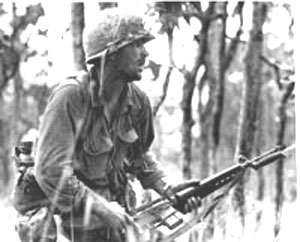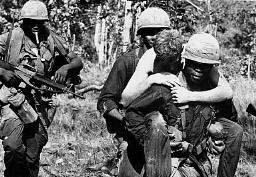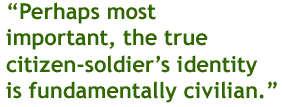Volunteers
[to top] |
||||
 who
served in the military from 1964 to 1965 were volunteers.1 The
statistics for the entire Vietnam Era are even more revealing. From
the period August 1964 to May
1975, 9.2 million personnel served in the military
with 3.4 million actually serving in
the Southeast Asia Theater. Of this
latter number, 2.5 million served within the borders of South Vietnam
during the war. Only 648,500 of the 2.5 million were
draftees, or slightly more than 38 percent from the period January
1965 to May 1973. Nearly two-thirds of those service members who
served in the Southeast Asia Theater in the Vietnam War were volunteers.2
Outside of the Southeast Asia Theater, the
percentage of volunteers rises to nearly 75 percent for the Vietnam
Era up through 1971.3 who
served in the military from 1964 to 1965 were volunteers.1 The
statistics for the entire Vietnam Era are even more revealing. From
the period August 1964 to May
1975, 9.2 million personnel served in the military
with 3.4 million actually serving in
the Southeast Asia Theater. Of this
latter number, 2.5 million served within the borders of South Vietnam
during the war. Only 648,500 of the 2.5 million were
draftees, or slightly more than 38 percent from the period January
1965 to May 1973. Nearly two-thirds of those service members who
served in the Southeast Asia Theater in the Vietnam War were volunteers.2
Outside of the Southeast Asia Theater, the
percentage of volunteers rises to nearly 75 percent for the Vietnam
Era up through 1971.3
|
||||
Motivation
[to top] |
||||
|
||||
| |
||||
Representation
[to top] |
||||
|
||||
Identity
[to top] |
||||
|
|
||||
Conclusion
[to top] |
||||
|
|
||||
1 U.S. Congress, Senate, Report of the Senate Armed Services Committee Hearings on Selective Service and Military Compensation, 92d Congress, February 1971, 58-59. 2 See the website “Vietnam War Statistics,” Available online at http://www.no-quarter.org/html/jake.html, accessed via the Internet on 20 October 2001. These statistics were compiled by the Veterans of Foreign Wars using open access information from the Department of Defense. 3 U.S. Congress, Senate, Report of the Senate Armed Services Committee Hearings on Selective Service and Military Compensation, 92d Congress, February 1971, 58-59. 4 Peter Karsten, The Military in America: From the Colonial Era to the Present, (New York: The Free Press, 1986), 414. 5 Andrew Carroll, ed., War Letters: Extraordinary Correspondence from American Wars, (New York: Scribner, 2001), 440. 6 W. D. Ehrhart, “The Volunteer,” available online at http://www.pbs.org/wgbh/amex/vietnam/reflect/ehrhart.html, accessed via the Internet on 11 November 2001. 7 Michael
Useem, “The Educational and Military Experiences of Young Men During
the 8 Sue E. Berryman, Who Serves? The Persistent Myth of the Underclass Army, (Boulder, Colorado: Westview Press, Inc., 1988), 39. Berryman compiled data on the social representation of the military for three episodes of war (World War II, the Korean War, and the Vietnam War). The data came from two linked surveys, both conducted by the U.S. Bureau of the Census: the March, 1973, Current Population Survey (CPS) and the August-November, 1973, Occupational Changes in a Generation Survey (OCG). 9 See the website “Vietnam War Statistics,” Available online at http://www.mrfa.org/vnstats.htm, accessed via the Internet on 20 October 2001. These statistics were compiled by the Southeast Asia Statistical Summary, Office of the Assistant Secretary of Defense, available from the U.S. Army War College Library, Carlisle Barracks, Pennsylvania. Additionally, the Combat Area Casualties Current File for Southeast Asia as of December 1998 was also consulted. This file, maintained at the National Archives and Records Administration, is the basis for the names inscribed on the Vietnam Veterans’ Memorial in Washington, D.C. 10 Eliot A. Cohen, “Twilight of
the Citizen-Soldier,” Parameters (summer 2001): 23-28. |
||||



